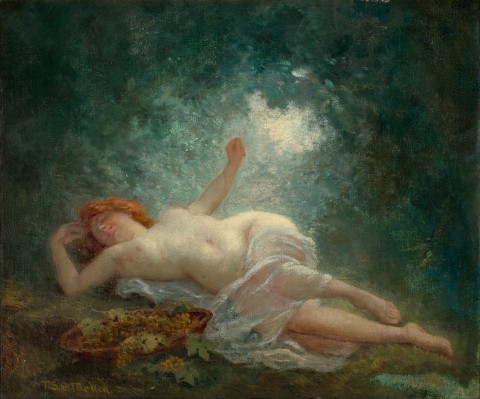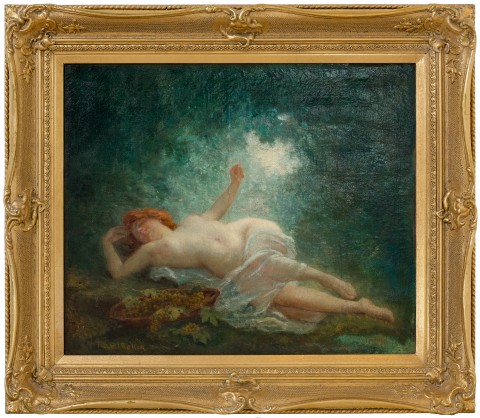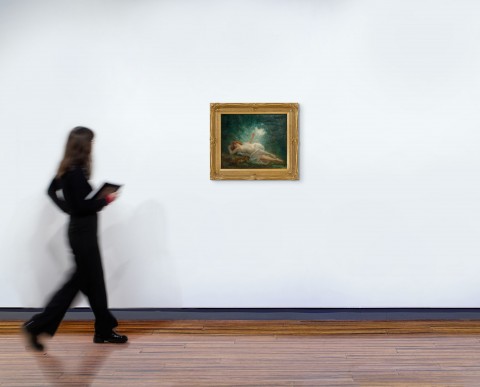DAY DREAMS, c.1892
TUDOR ST GEORGE TUCKER
oil on canvas
45.0 x 54.5 cm
signed lower left: T. S. G. Tucker
Private collection
Sotheby's, Melbourne, 17 April 1989, lot 374 (as 'Sleeping Nymph')
Henry Krongold, Melbourne
The Estate of Paul Krongold, Melbourne
Victorian Artists’ Society Exhibition of paintings, sculpture & drawings, Victorian Artists’ Society, Melbourne, April 1893, cat. 40
Victorian Artists’ Society Exhibition of Australian Art past and present, National Gallery of Victoria, Melbourne, August 1893, cat. 118
‘Art and artists: Mr. Tudor St. G. Tucker’, Table Talk, Melbourne, 26 August 1892, p. 6
‘Victorian Artist’s Society’, The Argus, Melbourne, 20 April 1893, p. 7
In August 1892, just months after his return from Paris, a reporter from Table Talk conducted an interview with Tudor St. George Tucker in his new Melbourne studio in Flinders Street. The reporter describes in detail much of what he saw there as he conversed with the artist, particularly the powerful Picardy Shrimpfisher, 1891 (Warrnambool Art Gallery), on display in prime position following its successful debut the previous year at the Salon de la Société des Artistes Français where it was hung ‘on the line.’ The reporter was also attracted to an unfinished oil sketch on another easel of a woman waking from sleep that he predicted would be ranked as a chef d’ouvre (masterpiece) when completed.1 Tucker subsequently titled this work Day dreams, c.1892 and entered it into two exhibitions at the Victorian Artists’ Society in 1892 where its evocative mood drew critical praise from the reviewer.
Tucker was English by birth but came to Australia for his health in 1881, aged 19. Between 1883 and 1887 he trained at the National Gallery School under George Folingsby where co-students included Rupert Bunny, Emanuel Phillips Fox, John Longstaff and Arthur Streeton. In 1887, Tucker and Fox left for Paris, with both studying at the Académie Julian under William-Adolphe Bouguereau, the acclaimed painter of classical nudes, and then with Jean-Léon Gérôme at the Ecole des Beaux-Arts. In 1890, Charles Conder wrote that ‘the American [art] students here tell me that Tucker is the strongest man from Australia in Paris and Fox is also thought a great deal of.’2 Day dreams displays the rigour of successful French academic training. As the Table Talk reviewer went on to describe, it features ‘a young peasant girl, just awakening from a sleep in a grassy glade in an autumn tinted wood. The landscape is unfinished, though sketched in with firm, bold touches, reproducing the glow and warmth of the fading summer. The figure of the sleeper is admirably posed, the outline correct, and the colouring very pleasing by its complete harmony and the brilliant effect of the light.’3 Next to her lies a platter of grapes, a fruit which comes into season in autumn. Grapes are also symbolic of Dionysus (also known as Bacchus), god of fertility and wine, whose festivals featured copious amounts of drinking and sensual revels. The implied suggestion is that the girl has partaken of many pleasures during the evening and now wakes in a secluded den of leaves, through which the sun is slowly streaming. When exhibited at the Victorian Artist’s Society, the reviewer for The Argus noted the similarity to Raphael Collins’ Floréal, then hanging in the Louvre,4 and there is a marked similarity indeed. However, where Collins’ figure was obviously painted in the studio and superimposed on a brightly coloured, flower-strewn riverbank, Tucker’s model is more believably enveloped by her surroundings.
In 1894, Tucker and Fox established the Melbourne Art School at ‘Charterisville’, an old stone house in Ivanhoe. It quickly became the city’s leading academy, nurturing a new generation of significant artists including Hugh Ramsay, Christine Asquith Baker, Ina Gregory and Violet Teague. Unfortunately, Tucker’s health began to fail and he returned to London, settling in Chelsea, where he died of tuberculosis at age 44, a tragically early death for such a talented painter.
1. ‘Art and artists: Mr. Tudor St. G. Tucker’, Table Talk, Melbourne, 26 August 1892, p. 6
2. ‘Mr. Charles Conder’, Table Talk, Melbourne, 1 August 1890, pp. 14 – 15
3. ‘Art and artists: Mr. Tudor St. G. Tucker’, ibid.
4. The painting is now housed in the Musee D’Orsay, Paris
ANDREW GAYNOR


